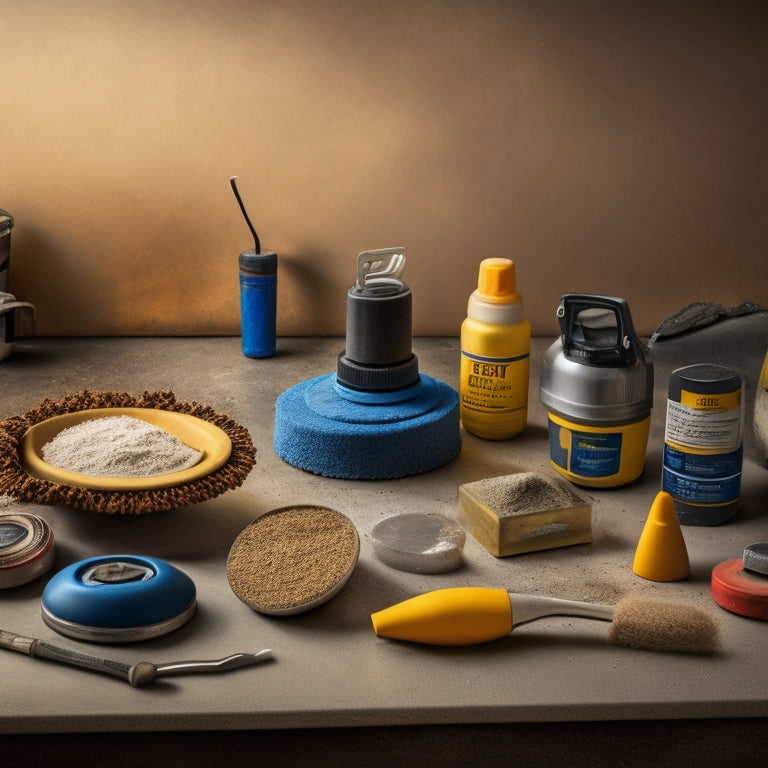
3 Best Tools for Removing Sealant From Concrete
Share
When removing sealant from concrete, you'll want to contemplate three key tools: chemical sealant removers, mechanical removal tools, and heat guns. Chemical removers dissolve residue for easy scraping, while mechanical tools like putty knives, rotary hammer scrapers, and floor scrapers are effective for scraping off sealant. Heat guns soften sealant for easy removal with a scraper or putty knife. Regardless of the method, it's vital to take safety precautions, such as wearing protective gear and working in a well-ventilated area. By understanding these options, you'll be well on your way to successfully removing sealant from your concrete surface - and there's more to explore to get the job done right.
Key Takeaways
• Use chemical sealant removers, which are biodegradable and effective, but require safety precautions and ventilation.
• Mechanical removal tools like putty knives, rotary hammer scrapers, and floor scrapers are ideal for scraping off sealant in small and large areas.
• Heat guns can soften sealant for easy removal, but require protective gear and caution to avoid fires and flammable materials.
• Grinders and sanders are essential for removing remaining residue and achieving a smooth finish after sealant removal.
• Always test products on an inconspicuous area and wear protective gear, such as gloves, goggles, and masks, when removing sealant from concrete.
Chemical Sealant Remover Options
When tackling stubborn sealant residue on concrete, you'll likely turn to chemical sealant remover options, which are specifically designed to break down and dissolve the sealant, making its removal a whole lot easier.
These products can be highly effective, but it's important to choose the right one for your project. You'll want to take into account biodegradable options, which are gentler on the environment and can reduce your environmental impact.
However, even with eco-friendly products, safety precautions are vital. Always wear protective gear, including gloves, goggles, and a mask, to prevent skin and eye irritation and inhalation of harmful fumes.
Before applying the remover, make certain the area is well-ventilated and free from any debris or obstructions. Follow the manufacturer's instructions carefully, and test the product on a small, inconspicuous area first to verify it won't damage the underlying concrete.
Mechanical Removal Tool Choices
You'll also want to explore mechanical removal tool choices, which can be a more aggressive and faster approach to removing sealant residue from concrete, especially for larger areas or thicker sealant buildup. This method is ideal when you need to remove a significant amount of sealant quickly.
Here are some mechanical removal tool options to take into account:
-
Putty knives and scrapers: Use these to scrape off as much sealant as possible, working in small sections to avoid spreading the residue.
-
Rotary hammer scrapers: These power tools are effective for removing thick sealant buildup, especially on larger areas.
-
Floor scrapers: Designed for removing old adhesives and sealants, these tools come in various scraper types and are often used with power tools.
- Grinders and sanders: Use these to remove remaining sealant residue, working your way up to higher grits for a smooth finish.
When using mechanical removal tools, be certain to work in a well-ventilated area and wear protective gear, including gloves, safety glasses, and a dust mask.
Remember to test a small area first to confirm the tool you've chosen won't damage the concrete surface.
Heat Gun Sealant Removal Methods
Using a heat gun is another effective method for removing sealant from concrete, as it can soften the residue, making it easier to scrape away.
You'll need to employ heat gun techniques that guarantee you're applying the right amount of heat to the sealant without damaging the surrounding concrete. Start by holding the heat gun about 6 inches away from the sealant, moving it slowly back and forth to evenly distribute the heat. As the sealant begins to soften, use a scraper or putty knife to gently remove it.
It's essential to take safety precautions when using a heat gun. Make sure you're wearing heat-resistant gloves, safety glasses, and a face mask to protect yourself from heat and debris.
Keep a fire extinguisher nearby, and avoid using the heat gun near flammable materials. Additionally, test the heat gun on a small, inconspicuous area of the concrete first to guarantee it won't damage the surface.
Frequently Asked Questions
Can I Reuse Concrete After Removing Old Sealant?
You're wondering if you can reuse concrete after removing old sealant.
The answer is yes, but it depends on the sealant removal techniques you use.
If you've carefully stripped the old sealant without damaging the concrete, you can definitely reuse it.
This approach offers concrete reuse benefits, like reducing waste and saving resources.
How Do I Prevent Sealant Residue From Re-Adhering?
The residue revenge: it's a vicious cycle, isn't it? You remove the old sealant, only to have it come back to haunt you.
To break the spell, you'll need to guarantee a residue-free surface before reapplying sealant. Clean the concrete thoroughly, then use a degreaser to remove any remaining residue.
Next, perform a thorough surface preparation, including etching and rinsing, to create a fresh canvas for your new sealant application.
What Safety Precautions Should I Take When Using Chemicals?
When handling chemicals for sealant removal, you'll want to prioritize your safety above all.
Make certain you're wearing protective equipment like gloves, goggles, and a face mask to prevent skin and eye irritation.
Always read the label instructions and follow the recommended chemical handling procedures.
Wear long sleeves and pants to protect your skin from splashes, and guarantee good ventilation to avoid inhaling fumes.
Don't take any risks – it's always better to err on the side of caution.
Can I Remove Sealant From Decorative Concrete Surfaces?
You can remove sealant from decorative concrete surfaces, but it's essential to identify the sealant type first.
Acrylic, polyurethane, and epoxy-based sealants require different removal approaches. For instance, acrylic sealants can be stripped with solvents, while polyurethane-based sealants may need mechanical scraping.
Always test a small area first to guarantee the removal method won't damage the decorative concrete.
Does Removing Sealant Affect the Concrete's Structural Integrity?
'Safely stripping sealant is a sensitive step in concrete maintenance.
You're right to wonder: does removing sealant affect the concrete's structural integrity? Fortunately, it typically doesn't, as long as you use the right techniques and tools.
Sealant longevity relies on a strong bond with the concrete, but removal won't compromise the concrete's underlying structure.
Conclusion
You've navigated the treacherous landscape of sealant removal, and now you're standing victorious, with the concrete floors of your domain freed from their sticky shackles.
But remember, the battle's not won without a strategy. Choose your weapon wisely - chemical, mechanical, or heat-based - and wield it with precision.
The right tool will be your trusty steed, carrying you to triumph over even the toughest sealants.
Ride forth, conqueror, and claim your concrete kingdom!
Related Posts
-

10 Best Tools for Sealed Concrete Flooring on Budget
When starting on a sealed concrete flooring project on a budget, you'll need to prioritize essential tools without sa...
-

3 Best Hand Tools for DIY Concrete Construction
When tackling a DIY concrete construction project, you'll need three essential hand tools to achieve a professional-l...
-

What Tools Ensure Precise Concrete Leveling Results
You need a range of specialized tools to achieve precise concrete leveling results. Laser leveling instruments provid...


